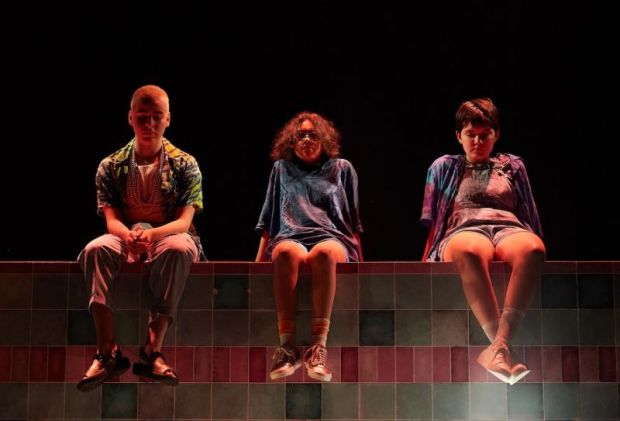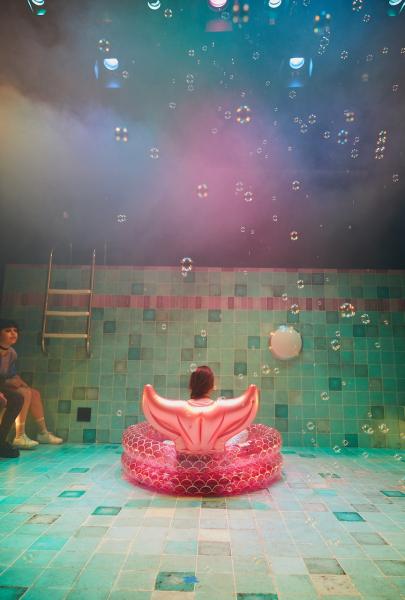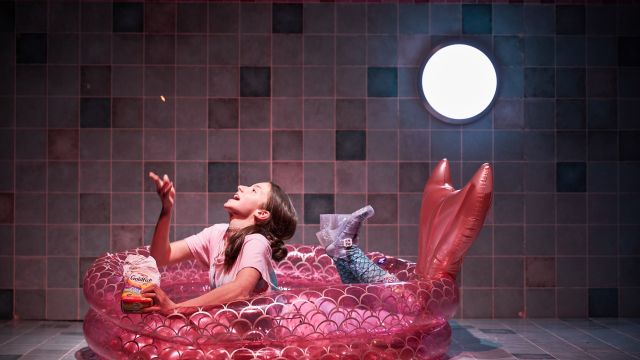The Mermaid
A joyous piece of collaborative invention by the teenage cast and adult theatre makers (too many to list here), The Mermaid takes off from Hans Christian Andersen’s 1837 tale and makes something funny, moving, and sophisticated. Part agit-prop, part comedy-drama, part satire and stand-up, the text throws in references to the 1989 subversive Disney animation, to Sophia Coppola’s aborted movie of the fairy tale (including quotes from the script), and a repeated catalogue of all the acts of misogynistic vandalism perpetrated on the famous statue in Copenhagen.
With all these elements, The Mermaid could have been a mess. It is not. Text and the direction of Cassandra Fumi meld things into a cohesive whole, slipping smoothly from narrative, to monologue, to interludes of movement that create resonant images. The set is a key factor in tying things together. Designer Dann Barber gives us a very naturalistic swimming pool, with beat-up old tiles, underwater lights, and a ladder for getting in and out. It’s a public space where teenagers meet - and a space where they are on display and under scrutiny: body image and gender definition are important sub-texts here.

But with a change of Rachel Burke’s lighting, sound from Bianca Montagner, and music from Montagner, Christopher Bolton and Ivy Luo, this swimming pool becomes under the sea, with dappled light and bubbles of air, the home of the mermaids and our central character, The Mermaid (An Dang). Dann Barber puts the performers in just slightly blinged but typical teen gear; there are no flipping mermaid tails in this show. The satirical exception is The Prince (Casper Plum), the putative lover for whom the Mermaid might give up her freedom and identity. The show has a lot of fun with The Prince and Caspar Plum goes with it: his Prince is a preening, grinning idiot, so conceited that he hardly needs to acknowledge anyone else’s presence. The Mermaid’s confusion and doubt as she pays homage to this ridiculous figure is arresting – and involves a lot of tennis balls. Somehow, that works too.

This is a VCE project, developed over a long period. If my brief description above seems a little ‘out there’ experimental and confusing, my companion this time, just a little younger than the kids on stage, ‘got it’ completely. These are not trained actors, but she was quite rightly most impressed with the acting. The nervousness and exuberance of being on stage might peep through occasionally, but this is a disciplined cast with a firm grip on what and why they are doing things, from coordinated movement through to complex and often poetic dialogue. My young companion, a sharp cookie, had one criticism: ‘At the end, it’s too quick, it just happens.’ She’s right, the climax does fall a little disappointingly flat.

But here is another show that makes a protest – a persuasive, non-hectoring one – against stereotyping and the suppression of identity – and does it with wit, ingenuity, tempered anger, and a real feeling for how live theatre works. This is definitely a theatre show – that is, it has the immediacy, intimacy, and allusive suggestion of live performance; it couldn’t be done on film or television. See it, please, for the sheer energy and fun – and take the kids.
Michael Brindley
Photographer: Pier Carthew
Subscribe to our E-Newsletter, buy our latest print edition or find a Performing Arts book at Book Nook.

